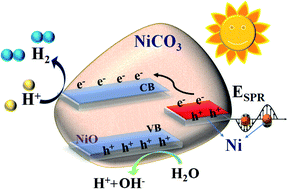Surface plasmon-driven photocatalytic activity of Ni@NiO/NiCO3 core–shell nanostructures
Abstract
Ni@NiO/NiCO3 core–shell nanostructures have been investigated for surface plasmon driven photocatalytic solar H2 generation without any co-catalyst. Huge variation in the photocatalytic activity has been observed in the pristine vs. post-vacuum annealed samples with the maximum H2 yield (∼110 μmol g−1 h−1) for the vacuum annealed sample (N70-100/2 h) compared to ∼92 μmol g−1 h−1 for the pristine (N70) photocatalyst. Thorough structural (X-ray diffraction) and spectroscopic (X-ray photoelectron spectroscopy and transmission electron microscopy coupled electron energy loss spectroscopy) investigations reveal the core Ni nanoparticle decorated with the shell, a composite of crystalline NiO and amorphous NiCO3. Significant visible light absorption at ∼475 nm in the UV-vis region along with the absence of a peak/edge corresponding to NiO suggest the role of surface plasmons in the observed catalytic activity. As per the proposed mechanism, amorphous NiCO3 in the shell has been suggested to serve as the dielectric medium/interface, which enhances the surface plasmon resonance and boosts the HER activity.



 Please wait while we load your content...
Please wait while we load your content...